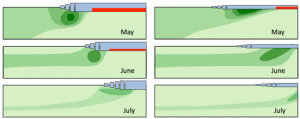Beyond expectations
Building up a large multidisciplinary project like Green Edge takes years. Our first proposal for getting funding support was submitted in early 2013, and then many others were submitted to various French and Canadian funding agencies and foundations over the following 2 years to reach the amount of money required to undertake this endeavour. The logistical planning of the 2015 and 2016 expeditions started during late fall 2014. The ambition was very high, the number of unknowns elevated, and the risks huge. The target of the Green Edge field program was to describe the phytoplankton bloom and all related aspects at unprecedented time and spatial scales.

Even a carefully designed conceptual framework and perfect logistical preparation (which was nearly achieved) were not enough to guarantee success in reaching our target. Mother nature had to be with us too! Indeed, blooms do not always occur at the same time of the year and in the same spot. Their extent and magnitude vary from year to year. The cruise plan is based on a conceptual design of the sampling strategy, which is derived from a conceptual model of the phenomenon under study that take the form of simple diagrams such as :

Often, reality turns out to be quite different from the conceptual approach. Things do not happen in the field as initially planned. Many compromises must be made to compensate for unexpected conditions (more or less ice, bad weather, scientific equipment failure, …). There may also be little or no bloom in a particular year. Scientific objectives often need to be readjusted a posteriori to the data that were collected.
But as the scientific leader, I can now claim that the Green Edge consortium reached its objective and that the field expeditions were fully successful. We documented spring blooms in both 2015 and 2016 according to plan. The bloom occurred when and where, and to the extent we expected. I can even say that we surpassed our expectations. We documented the bloom more intensively than initially planned and the initial data appear to be outstanding. The information that we acquired will provide an unprecedented increase in our understanding of this important natural phenomenon, its impact on the Arctic food web, and its evolution over the next decade.
Time for great science now!